How Substantial Media of North Carolina amplifies positive voices within the Black community
Greg Hedgepeth, Substantial Media LLC,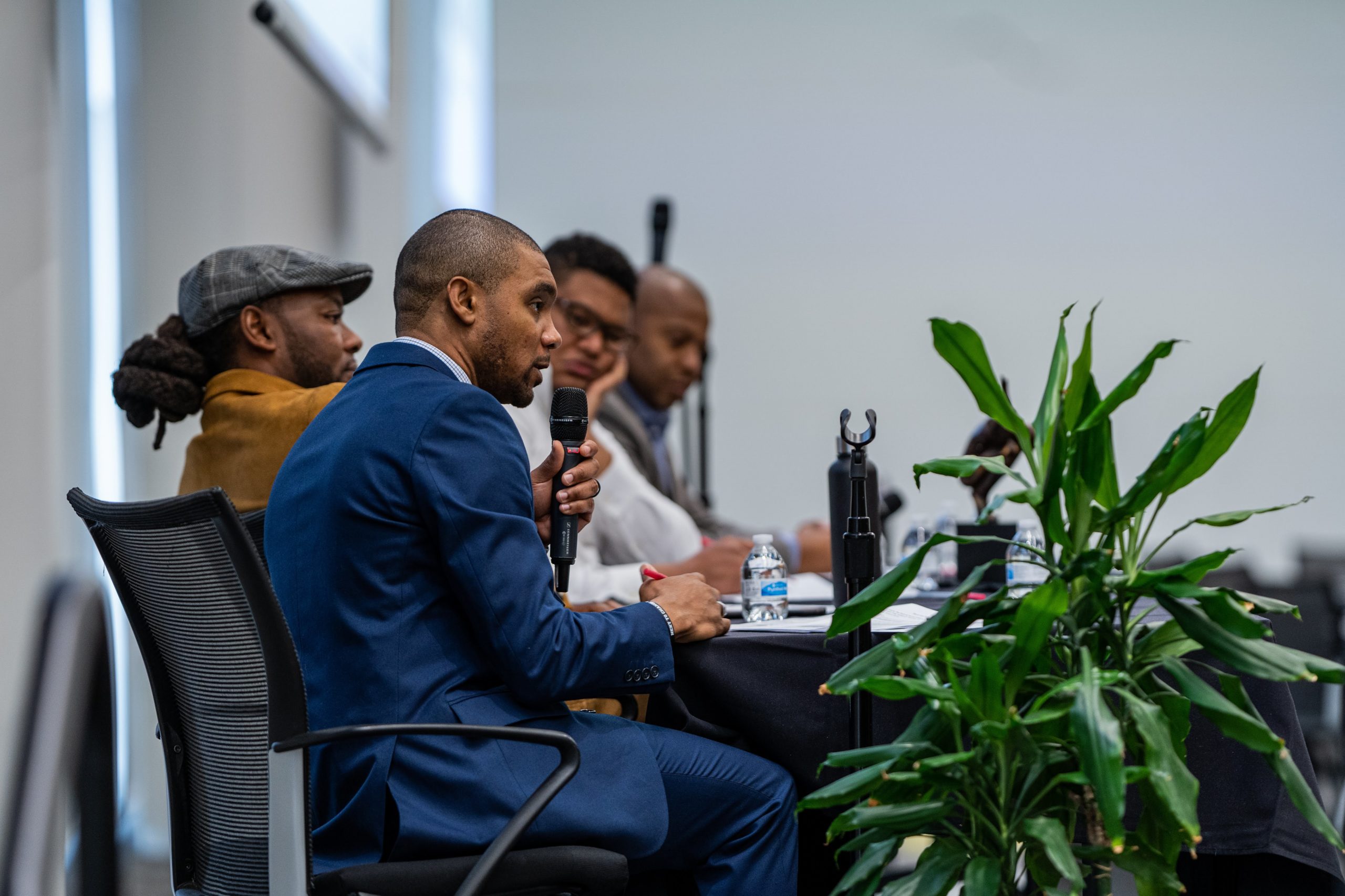
Greg Hedgepeth, president and CEO of Substantial Media LLC, leads a panel discussion at Black Lens Symposium, which was hosted by Substantial. (Dalvin-Earl Nichols/8-Bit Photography)
Here’s an idea to steal and adapt: Create an online subscription-based platform that produces editorial content focused on amplifying positive stories within the Black community, raising awareness regarding relevant issues that affect the community at the local, state and national level.This is a series on Better News to a) showcase innovative/experimental ideas that emerge from the Knight-Lenfest Newsroom Initiative and b) share replicable tactics that benefit the news industry as a whole. This “win” comes from Greg Hedgepeth, president and CEO of Substantial Media LLC. Substantial participated in the UNC-Knight Foundation Table Stakes program in 2021-22.
Question: What communities do you serve and what can you tell us about the history of your organization?
Answer: Substantial Media LLC is a Black owned and operated online subscription-based platform that produces editorial content focused on amplifying positive stories within the Black community. Substantial also raises awareness regarding relevant issues that affect our community at the local, state and national level.
We serve as a digital platform for Black news and stories that inform, educate and empower. We serve Eastern North Carolina, home to a lot of the state’s rural counties, and some of our largest cities to include Raleigh, Durham, Greensboro and Charlotte.
While our content primarily focuses on minority- and women-led businesses, we also cover the arts, public policy that affects Black communities and topics related to community advocacy.
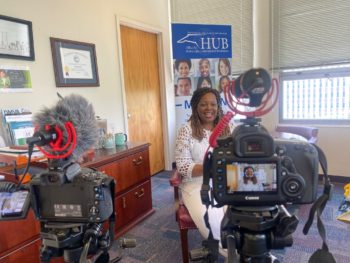
Substantial interviews Tammie Hall, Assistant to the Secretary and HUB Director, Office of Historically Underutilized Businesses, NC Dept. of Administration. (Greg Hedgepeth/Substantial Magazine)
We saw a need to highlight the amazing work and substantial contributions that people of color have made in certain parts of our state and how their work has lifted both their communities and the overall economy.
Substantial has grown and evolved over 12 years, having started as a printed magazine with very little digital presence outside of Greenville, N.C., to a full-scale digital operation that spans the aforementioned locations.
We’ve been honored to partner with several organizations and institutions including the City of Greenville, East Carolina University, ECU Health (formerly Vidant Health), the Carolina Small Business Development Fund, The National Institute of Minority Economic Development, and several nonprofits that promote Black excellence and build awareness in communities of color.
Q: What problem were you trying to solve, and why was solving the problem strategically important for your organization?
A: For Substantial, it was always one-off wins or small victories. While these moments had significant impact, none of them allowed for real sustainable revenue generation.
The problem we, and I believe many other Black-owned publishing companies and media outlets, are trying to solve revolves around our ability to create sustainable revenue models that allow us to scale and become a valuable component within North Carolina mass media.
While there are so many more important things than money, it takes money to do all of those important things. We believe solving this problem will allow us to further develop our strategic partnerships to create both financial and human capital, thus making a substantial impact on our local economies.
We want Substantial to be positioned as an innovator in the communications industry that can cultivate young Black talent that may not often get the opportunity to prove their value within larger mainstream outlets starting off.
For us, the mission is twofold. One: We have to ensure we are documenting our rich history and highlight the amazing work that Black people are doing within our state. Two: We have to continue to ensure the life and legacy of Black-owned press/media and build a place for passionate young people to thrive and share their talents.
Q: How is this approach related to Table Stakes (e.g. one of the 7 Table Stakes and/or an outgrowth of the Knight-Lenfest initiative, etc.)?
A: This initiative is directly related to Table Stake No. 3 (“Produce and publish continuously to meet audience needs”), Table Stake No. 5 (“Diversify and grow the ways you earn revenue from the audiences you build”) and Table Stake No. 6 (“Partner to expand your capacity and capabilities at lower and more flexible cost”).
Here’s some more context: When I think about the purpose of Table Stakes, which is to teach modern change management skills to develop new leaders and business models for local news, our approach is uniquely tied to this very thing.
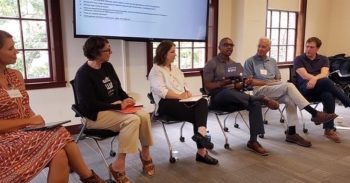
Greg Hedgepeth (center) joins Table Stakes colleagues Erica Perel (from left), Chrissy Beck, Courtney Mitchell, Les High and Kyle Villemain, in a panel conversation about collaborations. (Myron B. Pitts/The Fayetteville Observer)
I didn’t grow up in the news and journalism space; I’m not a “big J” journalist as they say. I’m a marketing and communications professional and social entrepreneur, who sees himself as a servant leader and change agent.
Substantial joined Table Stakes to learn and hear the various challenges that local media is facing. We also joined to hear and share the innovative approaches people are taking to ensure sustainability and future progression. Substantial’s focus has always been to put our audience at the center, and we believe we try hard to accomplish all seven of the Table Stakes in our work.
Q: How did you go about developing partnerships that help generate revenue?
A: It started with understanding our unique value in the market space and what it was we could offer in the development of any partnership.
For lack of better words, what were we bringing to the table? For us, it was our audience, of course, but more so it was our hybrid approach to how we’ve built our audience and the relationship we’ve been able to develop over time.
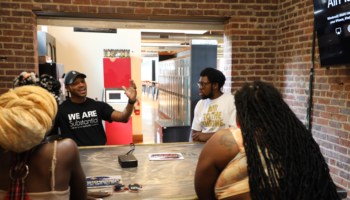
Greg Hedgepeth, president and CEO of Substantial Media LLC, talks with other local entrepreneurs at a Black-owned co-working space in downtown Raleigh. (Jonathan Leach/Substantial)
I often say Substantial is not your traditional news outlet. We don’t necessarily fit neatly in one of the industry boxes. We value how we develop positive content and longform highlights on our Black people, their businesses and our community. This is valuable, especially in the aftermath of George Floyd’s murder and the racially charged climate we find ourselves in. As trust in mainstream media continues to wane, and businesses and institutions continue to launch DEI related initiatives, small niche audiences like ours continue to be an asset in getting information into our local communities.
From there, we found organizations and institutions that match our existing audience demographics, and that needed to have trusted sources to share information and communicate with our audience.
These partners also believed in our values and approach. From there, we partnered to ensure we developed content opportunities and verticals that would meet the needs of our partners, while holding true to the information we found necessary to be communicated.
We also developed opportunities to partner with organizations that understood the challenges and wanted to see the success of Black owned and operated outlets. Through the hosting of events like the Substantial Awards, The Black Lens Symposium and National Black Student Leadership Conference, we found other ways to strengthen the relationship with our audience and provide meaningful opportunities to partner with us.
Two examples are our partnerships and ongoing relationship with The Diversity Movement and The African American Alliance of CDFI CEOs (The Alliance) .
Through these unique partnerships, we developed branded content opportunities that allow us to not only develop relevant and relatable content, but we’ve also been able to ensure our audience sees these two very important organizations as allies and advocates for our community.
Through our partnership with the Alliance we have developed a storytelling series that looks to explore how Black-led Community Development Financial Institutes (CDFIs) are in a unique position to ensure the economic stability of Black communities. A few examples of these stories are:
- Why Black-led CDFIs are in a unique position to ensure the economic stability of Black communities
- A $27 Billion Opportunity to Prioritize Environmental Equality
- Cultivating talent and providing opportunities to enrich the HBCU student experience
Q: How did learning more about your core audience inform your overall strategy?
A: It was the most vital part of us being able to understand our unique value-add when it came to truly reaching out to businesses.
It’s one thing to say we serve the Black and brown communities across North Carolina. It’s something else entirely to do a level of customer discovery that allows you to break down who those people are, what they care most about and where exactly they are willing to spend their time, talent and treasure.
We needed to understand them and learn more about what it takes to move them down the marketing funnel. That allowed us to build story concepts that we matched up with businesses and organizations that would be willing to sponsor and contribute. They entirely informed our content strategy, thus informing our sales strategy.
Originally we set out to serve all Black people in every community across NC and we quickly learned that there were so many micro segments within this larger population. We couldn’t very well be all things to all people. We surveyed our audience, researched who was attending our events, sharing our content and also contributing stories. We went from attempting to serve all, to specifically our minority business owners and entrepreneurs. We immediately saw an increase in readership and this shift gave us an opportunity to tailor our stories even more.
Q: What worked?
A: It was our ability to meet the needs of our partners and provide a service that went beyond the traditional marketing mediums and channels.
I attribute a portion of this success to Substantial having participated in the Meta Branded Content Project. These partnerships work and continue to work because we developed audience-focused revenue products and services geared toward organizations that were looking for unique local advertising.
We also worked with them to develop content strategies that made sense and helped further their position in their markets as innovators that cared about the success and well-being of communities of color.
We’ve had some early wins with this strategy and have generated about $40,000 in additional revenue. Our branded content packages range from $5,000 to $15,000 depending on number of stories, timeframe and overall scope of work.
We have a freemium to premium subscription model and have seen a slight increase in premium subscription growth. However we recognize that we have to do more to manage and retain our members. We are currently working to further develop our member engagement strategy that will hopefully help us market the benefits of a Substantial membership beyond just our digital publication. We’d like to partner with local minority businesses and other local Black owned outlets to offer additional benefits to being a Substantial subscriber. Growing our subscriber audience has been a challenge especially given there are so many ways to access free content.
Q: What didn’t work?
A: It’s been a challenge to ensure the messaging fits within our existing content delivery.
There was no easy one-size-fits-all approach. In some cases, we found that we had to truly tailor the pitch and content every time we reached out to a new partner. Granted, this is what we believe is unique about our approach, but it’s a double-edged sword as it relates to scalability, because it takes time to get each of these story series done well.
We have found it hard at times to sell the importance of unique small-market Black media outlets. We will never have the numbers of our mainstream or even white-led local media organizations. We have to make strong business cases for why organizations should trust in our ability to carry their messages and tell their stories in a way that converts or motivates our audiences.
What we’ve learned that works is our ability to match our audiences’ needs with organizations that have similar or the same values. We then share with these organizations how their brand aligns with our audience and how our outlet can be a channel to carry these messages into our community. It’s about building compelling stories and relationships. More importantly, we share how the organization can align itself as a resource for our community through storytelling which has proved to be more effective than traditional marketing at times.
Q: What part of your strategy has shown the most return on investment?
A: Our overall approach has shown great promise. With all things we do, we take a design-thinking approach, which allows us to define, ideate, develop and test with our audience. It’s this hybrid non-linear or non-traditional approach that has been successful thus far.
For example, we’ve noted a heavy interest in Black arts and culture within our audience, in doing research on organizations that cater to this segment of our community we have partnered to do a number of stories and events that may be of interest to our audience.
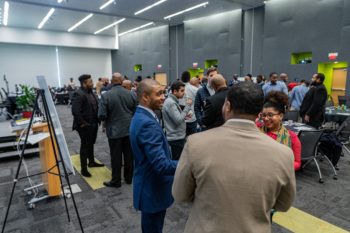
The Black Lens Symposium: “I AM therefore We ARE” was a celebration of Black history and Black excellence. (Dalvin-Earl Nichols/8-Bit Photography)
This has led to a partnership with the North Carolina Museum of Art (NCMA) to do an entire publication and storytelling series dedicated to Black arts and its impact on Black culture across North Carolina.
This will also serve as an opportunity to promote the upcoming NCMA Ruth E. Carter exhibition on Afrofuturism in Costume Design. It’s this type of content pivot and fluidity that I love about what we are continuing to create here at Substantial.
Q: What advice would you give to others who try to do this?
A: Start by knowing your audience. Who are they? What do they care about? Why do they care? How are those things they care about directly tied to the communities they live in and the organizations they serve?
Then do a complete profile on your company. What are your organization’s values, what opportunities do you now have to offer something that meets the needs of these organizations. What will be your unique value-add to the lives of your audience?
I say this because everyone can get the news from anywhere these days. What makes your news and organization special? Don’t get me wrong: This is not easy to do for those well established news and media outlets that have been in business for ages.
Change for some isn’t riding in a speed boat, rather a slow-to-turn cruise ship. The important thing to note is that you don’t want that ship to end up like the Titanic. Businesses, products and services evolve over time. This is no different for the news and media industry. Figure out your pivot and start building a business case for why it will work for your organization and benefit those within your sphere of influence.
Q: Is there anything else you’d like to add?
A: This has been a humbling opportunity to highlight some of our early wins and successes, but make no mistake, these lessons were learned over time and we’re still learning how best to stay true to our audience, while creating real revenue opportunities. If I had to add anything, I’d say find a way to ensure your organization remains relevant, relatable, reliable and resourceful.